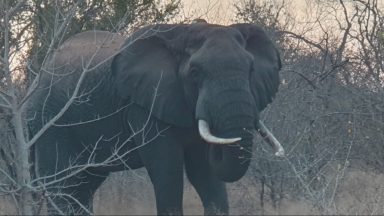Today, the action is happening in the Waterval Private Game Reserve in the Northern Cape. A mother and her sub-adult female cub, donated by cheetah conservationists, Ashia, have been darted by wildlife veterinarian Willem Burger in the field and taken by helicopter to a team waiting in a safe, shady location. These precious cats are carried carefully on stretchers with masks over their eyes to minimise stress, as they are extremely vulnerable animals. They run the risk of overheating whilst sedated, so the vets have to move fast, placing ice all around their bodies to keep their temperature stable. For each degree the body warms up they need 20 % more oxygen, so tubes are placed into their noses to deliver this to the sleeping cats. But cats can also die of pneumonia if their body temperature plummets, so the vets are with the cats continually, monitoring their temperature, checking their heart rate and managing the flow of oxygen.
Once a collar is fitted – which will be needed later to monitor their movements in their new home – and the cheetah are stable, they are gently manoeuvred into purpose-built crates on the back of a truck for the next part of their journey. At this stage they are given a shot to wake them up but still keep them slightly sedated so that they remain calm during transit.
The trucks drive them to the airfield where these most distinguished creatures will board the plane for their flight south to their new home in Maputo Special Reserve.
What these two female cheetah do not know is that two males are also being donated by Ashia from South Africa’s Phinda Private Game Reserve to join them in Maputo Special Reserve, and together they will make a founder population of cheetah that, in time, will increase the cheetah population there.
The importance of this translocation cannot be overstated. It really is an historic event. After many decades of destructive human impact in Mozambique, this collaboration between Peace Parks, ANAC and many other partners will introduce cheetah back into Maputo Special Reserve, where a phenomenal 19 000 animals now live, offering plenty of food for the cheetah. This is another step towards restoring a balanced environment and healthy ecosystem.

